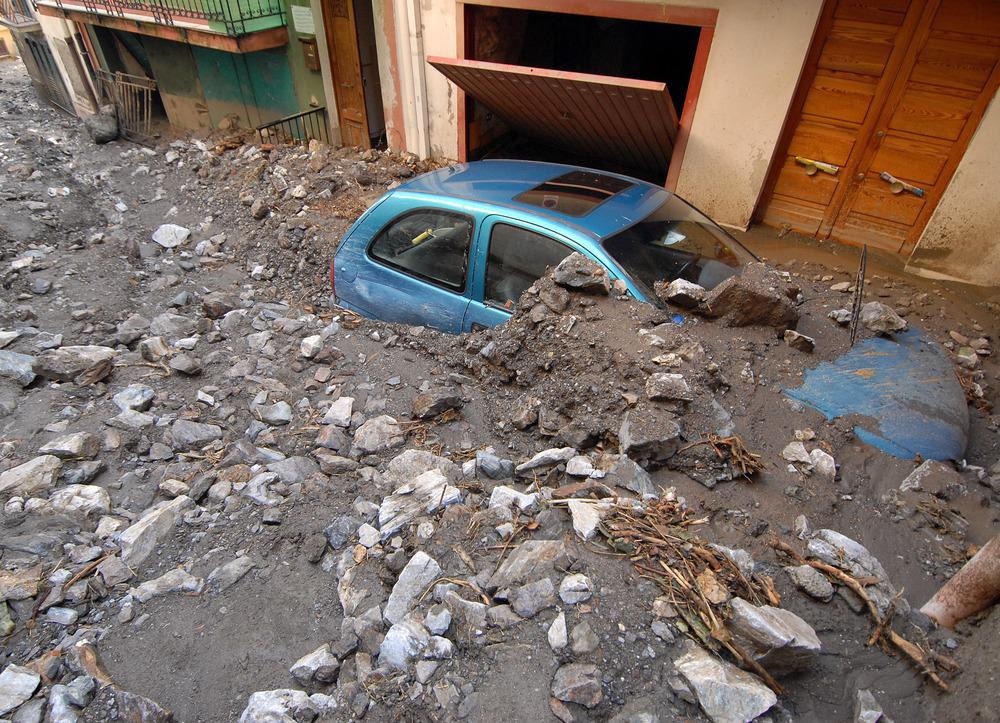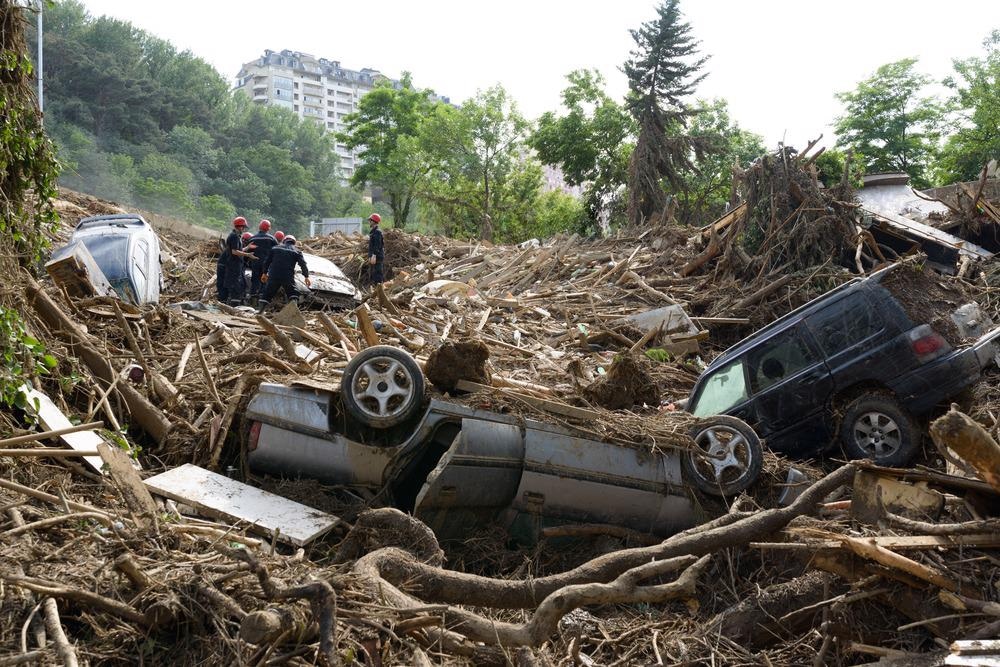Finding people trapped in the aftermath of a natural disaster is not just critical – it is a matter of life and death. Natural disasters are increasing as the climate warms; the Earth is experiencing more extreme weather, including flash-flooding and hurricanes, in addition to earthquakes, volcanic eruptions, and wildfires.

Image Credit: Lucky Team Studio/Shutterstock.com
However, it can be too dangerous for first responders to enter a collapsed building or too difficult to find survivors under a pile of rubble. In these situations, rescue robots could play a pivotal role: whether they fly, swim, crawl or slither, autonomous search and rescue robots are increasingly providing hope following natural disasters.
A Brief History of Rescue Robots
There are many different types of rescue robots, each designed with a specific purpose. Some roam the skies, mapping out suitable routes through flood-laden areas; others slither through the smallest cracks in collapsed buildings, searching for survivors following an earthquake, or cover the seas rescuing those trapped by high seas and strong winds.
Utilizing rescue robots to search unreachable or dangerous places was first proposed in the 1980s, but there was little uptake because the robots were fairly primitive. However, a turning point came in 1995 as search and rescue robots were thrust into the limelight following both manmade and natural disasters.
Small rescue robots were used to locate the Oklahoma City Bombing survivors in America before responders determined how to rescue them. A mix of fertilizer and fuel hidden in a vehicle was detonated outside a federal building, killing 168 people and destroying much of the building.
Conversely, large robots were used to dig through the rubble following the Hanshin-Awaji earthquake in Kobe, Japan. It was one of the worst in Japanese history, killing an estimated 6,400 people and damaging almost 400,000 buildings.
Although the approaches were very different, the potential of such robots to aid search and rescue efforts was made clear. This was confirmed by the attacks on the World Trade Center in 2001; rescue robots were deployed to find trapped survivors, entering spaces that were unsafe or too small for humans. Although no survivors were found, the robots provided valuable feedback under real-time conditions.
These Search and Rescue Robots Could Save Your Life
Video Credit: Freethink/YouTube.com
Improving Robotic Design with Inspiration from Nature
In the two decades that followed, search and rescue robots have evolved to become more sophisticated, often taking inspiration from nature to improve design and function, enabling them to traverse the harsh terrains associated with natural disasters.
Following a 7.1 magnitude earthquake in Mexico in 2017, snake robots from Carnegie Mellon University Biorobotics Laboratory were used to aid recovery efforts. These slim, reptilian-like robots have a modular design which gives them a unique range of movement. It also allows the robot to take on different shapes over different terrain and squeeze into tight spaces. These robots were relatively primitive and had limited success, but their creators noted improved cameras, thermal imaging, microphones, and speakers, would have further aided rescue efforts.
The American cockroach provided inspiration for roboticists at the University of California, Berkeley, who are developing a palm-sized robot that splays its legs sideways when flattened to squeeze into small cracks as quickly as possible. Named CRAM, a compressible robot with an articulated mechanism, it could be deployed in swarms to search rubble after a tornado or earthquake.
Another robot in development uses bees as its inspiration; roboticists from Harvard University recently sent a RoboBee on a solo, untethered flight sans power cord. Although it could be another 10 to 20 years before they become a reality, the roboticists predict the RoboBees could be deployed in swarms to search tight spaces.
How Successful are Rescue Robot Missions?
Search and rescue robots are deployed in scenarios that are too dangerous or unreachable for humans, such as fast-rising waters or flash flooding. There have been many successful missions over the years.
In 2016, EMILY, Emergency Integrated Lifesaving Lanyard, was deployed to rescue hundreds of asylum seekers trapped near the rocky coast of Greece. A joint venture from Hydronalix, the US Office of Naval Research, and the Navy’s Small Business Innovation Research, the hybrid floatation buoy-lifeboat enabled first responders to ferry people to safety.
Robotics engineers are still improving EMILY; future iterations will reduce human error and increase autonomy via drone tethering and thermal sensing technology.
When Notre Dame Cathedral caught fire in 2019, French company Shark Robotics came to the rescue with Colossus, who entered when conditions were too treacherous for humans. These fire robots are the most potent electric robot in the world and can withstand temperatures up to 900°C. They can also move equipment, transport victims, use thermal cameras to assess the scene, and prove useful, particularly with wildfire response.
Aerial robots and drones are ideal for assessing conditions following a natural disaster; their cameras can record and broadcast images to remote crews to give a real-time snapshot of the situation, while thermal imaging can spot survivors. They were successfully used following Hurricanes Katrina and Harvey to plan routes for rescue boats to reach people trapped by flooding and show an accurate scale of the devastation.
Other victories include Indago drones from Lockheed Martin, which have been fighting wildfires in Australia, and Drone Pilot, which has been used in many search and rescue operations, as well as crime scene and search assistance.

Image Credit: Dmytro Vietrov/Shutterstock.com
The Future of Rescue Robots
Robots and the level of autonomy they can bring are of concern, citing job replacement as a significant worry. Although this may occur for some sectors, it is not the case for rescue robots: search and rescue robots are performing a lifesaving task,
There are still many improvements that can be made – upgrading hardware and software, refining agility and movement, and overall design, for example. This will take time, and it may be decades before we see some of the aforementioned robots on the front line, but such robots will have a pivotal role in keeping people safe and providing hope following natural disasters.
References and Further Reading
Orlando, A. (2020) After Disaster Strikes, a Robot Might Save Your Life, Discover [Online]. Available at: https://www.discovermagazine.com/technology/after-disaster-strikes-a-robot-might-save-your-life
Gossett, S. (2019) 12 Examples of Rescue Robots, built in. [Online]. Available at: https://builtin.com/robotics/rescue-robots
Federal Bureau of Investigation. (2021) Oklahoma City Bombing | Federal Bureau of Investigation. [online] Available at: https://www.fbi.gov/history/famous-cases/oklahoma-city-bombing
Info.darley.com. (2021) Darley Robotics | EMILY Robotic Rescue System by Hyrdonalix. [online]. Available at: https://info.darley.com/robotics/emily-rescue-system
SHARK ROBOTICS. (2021) SHARK ROBOTS — SHARK ROBOTICS. [online] Available at: https://www.shark-robotics.com/shark-robots#rhyno
Disclaimer: The views expressed here are those of the author expressed in their private capacity and do not necessarily represent the views of AZoM.com Limited T/A AZoNetwork the owner and operator of this website. This disclaimer forms part of the Terms and conditions of use of this website.